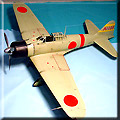| Matchbox is well known to many modelers as a company that produced a wide
variety of kits in the 1970's and 80's, all designed to appeal to the low-cost end of the
market. Their kits were simple and usually came in 2 or 3 different colors of
plastic so that once built by a novice modeler, they'd at least appear to be in something
like the correct color scheme without actually being painted. Detail was often weak
(or too coarse; beware the mad trencher!), but prices were low and variety was excellent,
with a number of subjects having never been kitted by any other company before or since.
The Privateer is one of these, and when Matchbox got out of the plastic kit business in the
80's, their molds were acquired by Revell, who has re-released many of them over the last few years.
|
|
![[This is the Revell reissue of the Privateer.]](PR-PB4Y2-071b.jpg) |
The Revell re-pop has new decals and is all one-color plastic, but it's the same
Matchbox mold. Construction begins by separating all the major pieces from the sprues.
Everything fits well enough, but the kit is engineered so that it can be built as one of three different
versions, one of which does not have the distinctive side gun blisters. There's a large square
hole in the fuselage that takes either a flat panel or the gun installation, and this requires some
filler and sanding to get rid of the large seam. There are also two different noses, with or
without the turret. Numerous windows along the sides are also available depending on which
version you're building, and you have to cut away the thin layer of plastic molded over the openings
you want. Be careful not to get the wrong ones!
|
|
|
| The Consolidated B-24 Liberator was produced in
larger numbers than any other bomber in history, and spawned a number of different variants.
Perhaps the most extreme adaptation of the original design was the PB4Y series, a version optimized
for Maritime patrol duties. During WWII the US Navy found that long range patrol planes,
ranging far out over the ocean, were very useful in spotting and attacking enemy ships and
submarines, and since the B-24's high efficiency Davis wing gave it longer range than any other
American aircraft at the time, it was a natural choice for the job. The PB4Y-1 was a mildly
modified B-24, but the -2 was a radical departure from the original with a completely different
single-fin tail, a lengthened fuselage, all-new defensive armament, and re-designed engine nacelles.
As the intended mission for the new bomber was low altitude patrol, the B-24's superchargers
were deleted along with the ventral gun turret.
|
Entering service in late 1944, it was first deployed in January of 45, patrolling the seas around the
Philippines and Marianas islands, but there wasn't much left of the Japanese navy for it to attack.
When the war ended it was pressed into service as a typhoon chaser, but when the Cold War began in the
late 40's, the Privateer found new life as an early spy plane. Equipped with cameras and ELINT
devices, it flew clandestine missions around and probably over the USSR and Communist China. 739
Privateers were built, the Navy retiring the last of them in 1954. The Coast Guard used them until
1958, and most ended their careers as target drones. Some were sold as surplus and adapted as cargo
planes and fire-fighting water bombers, but after one of the few left crashed and killed its 2-man crew in
2002, all others were grounded due to structural fatigue. The local Yankee Air Museum actually has a
PB4Y-2 in their static display area, which they acquired in 1987. It was being used as a fire bomber
and was donated to the museum after it was damaged when sliding off a runway.
|
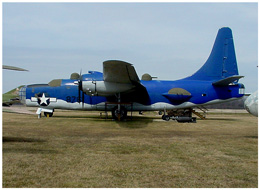 |
|

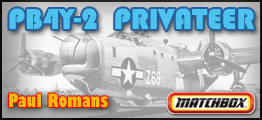
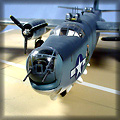



![[A Squadron replacement vac-form cockpit canopy set was used. ]](PR-PB4Y2-081b1.jpg)
![[The vac-form replacement for the rear turret was the wrong version so the poor fitting kit part was made to work. ]](PR-PB4Y2-063b1.jpg)
![[I had to add a lot of extra parts to simulate the complicated gun blister system.]](PR-PB4Y2-078b1.jpg)
![[All the turrets had some imagineered bits added to improve their looks.]](PR-PB4Y2-070b1.jpg)
![[The biggest problem with the entire kit was the dratted nose turret.]](PR-PB4Y2-065a.jpg)
![[It almost took a cast iron frying pan to get it to sit on its nose.]](PR-PB4Y2-056a.jpg)
![[Shims, putty, sanding, filing, cursing, pleading, were all used to fill the gap where the nose turret meets the fuselage.]](PR-PB4Y2-067a.jpg)
![[I wanted the three-tone dark blue - medium blue - white underside scheme of the late 40's US Navy. ]](PR-PB4Y2-074a.jpg)
![[The decals in the Revell reissue are extensive, and cover three versions.]](PR-PB4Y2-057a.jpg)
![[The landing gear were actually rather well done.]](PR-PB4Y2-068b1.jpg)
![[The kit-supplied props were poor and were replaced from an old Revell B-24D kit.]](PR-PB4Y2-066b1.jpg)
![[The soft paint edge was made using blue-tack craft putty rolled out in a thin rope and applied along the paint line.]](PR-PB4Y2-059a1.jpg)
![[Adding the Squadron vac-form canopies were a big improvement to the old Matchbox kit.]](PR-PB4Y2-062a.jpg)
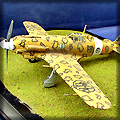
![[Back]](../../../USAAC-1.jpg)
